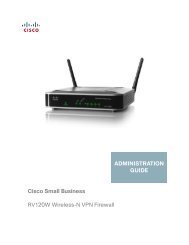Cisco WAP200 Wireless-G Access Point with PoE and ...
Cisco WAP200 Wireless-G Access Point with PoE and ...
Cisco WAP200 Wireless-G Access Point with PoE and ...
Create successful ePaper yourself
Turn your PDF publications into a flip-book with our unique Google optimized e-Paper software.
<strong>Wireless</strong>-G <strong>Access</strong> <strong>Point</strong> <strong>with</strong> Power Over Ethernet <strong>and</strong> RangeboosterThe <strong>Wireless</strong> - Advanced <strong>Wireless</strong> Settings TabThis screen allows you to configure the advanced settings for the <strong>Access</strong> <strong>Point</strong>. Linksys recommends to let your<strong>Access</strong> <strong>Point</strong> automatically adjust the parameters for maximum data throughput.Advanced SettingsCTS Protection Mode. CTS (Clear-To-Send) Protection Mode function boosts the <strong>Access</strong> <strong>Point</strong>’s ability to catchall wireless transmissions, but will severely decrease performance. Keep the default setting, Auto, so the <strong>Access</strong><strong>Point</strong> can use this feature as needed, when the <strong>Wireless</strong>-G products are not able to transmit to the <strong>Access</strong> <strong>Point</strong>in an environment <strong>with</strong> heavy 802.11b traffic. Select Disabled if you want to permanently disable this feature.BSSBasicRateSet. This setting is a series of rates that are advertised to other wireless devices as defined inIEEE 802.11 specifications, so they know which data rates the <strong>Access</strong> <strong>Point</strong> can support. One of the rates ispicked from the list for transmitting control frames, broadcast/multicast frames, or ACK frames. To support both802.11b & 802.11g devices, use the Default (Mixed mode) setting so that frames can be decoded by all devices.To support 802.11g devices only, use the All (G-only mode) setting to achieve higher frame rates. For regular dataframes, the transmission rate is configured through the Tx Rate Limiting on the <strong>Wireless</strong> - VLAN & QoS tab.Figure 6-15: <strong>Wireless</strong> - Advanced <strong>Wireless</strong>Power Output. You can adjust the output power of the <strong>Access</strong> <strong>Point</strong> to get the appropriate coverage for yourwireless network. Select the level you need for your environment. If you are not sure of which setting to choose,then keep the default setting, 100%.Beacon Interval. This value indicates the frequency interval of the beacon. A beacon is a packet broadcast bythe <strong>Access</strong> <strong>Point</strong> to keep the network synchronized. A beacon includes the wireless networks service area, the<strong>Access</strong> <strong>Point</strong> address, the Broadcast destination addresses, a time stamp, Delivery Traffic Indicator Maps, <strong>and</strong>the Traffic Indicator Message (TIM). The default is 100 ms.DTIM Interval. This value indicates how often the <strong>Access</strong> <strong>Point</strong> sends out a Delivery Traffic Indication Message(DTIM). Lower settings result in more efficient networking, while preventing your PC from dropping intopower-saving sleep mode. Higher settings allow your PC to enter sleep mode, thus saving power, but interferes<strong>with</strong> wireless transmissions. The default is 1 ms.RTS Threshold. This setting determines how large a packet can be before the <strong>Access</strong> <strong>Point</strong> coordinatestransmission <strong>and</strong> reception to ensure efficient communication. This value should remain at its default setting of2347. If you encounter inconsistent data flow, only minor modifications are recommended.Chapter 6: Configuring the <strong>Wireless</strong>-G <strong>Access</strong> <strong>Point</strong>The <strong>Wireless</strong> - Advanced <strong>Wireless</strong> Settings Tab25
















